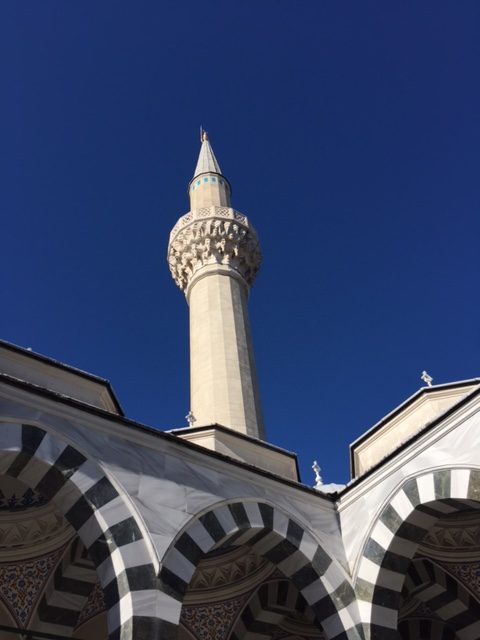 People who have faith have always needed a place of worship throughout history. Places of worship are where doctrines have been taught to the people and formal obligations have been fulfilled and are indispensable worldly elements of almost all religions, which direct people’s relations with both God and each other, as well as with other beings. Therefore, these sacred places have played a crucial role in starting communication between people. Thanks to such communication, those people who have known and bonded with each other, who have found solutions for their own problems, or who have taken a common stand, have considered such places as the safest centers as well. Some took refuge in temples to save their own lives, and some saints, who have broken off connections to people or the world, settled in temples to believe in the first step of happiness (nirvana), as well as some wealthy people who regarded temples as a place that they could deposit their wealth or gold. In this context, the theory that modern banking procedures emerged in temples seems not frail at all.
People who have faith have always needed a place of worship throughout history. Places of worship are where doctrines have been taught to the people and formal obligations have been fulfilled and are indispensable worldly elements of almost all religions, which direct people’s relations with both God and each other, as well as with other beings. Therefore, these sacred places have played a crucial role in starting communication between people. Thanks to such communication, those people who have known and bonded with each other, who have found solutions for their own problems, or who have taken a common stand, have considered such places as the safest centers as well. Some took refuge in temples to save their own lives, and some saints, who have broken off connections to people or the world, settled in temples to believe in the first step of happiness (nirvana), as well as some wealthy people who regarded temples as a place that they could deposit their wealth or gold. In this context, the theory that modern banking procedures emerged in temples seems not frail at all.
Tokyo Camii & Turkish Culture Center
http://www.tokyocamii.org/about/welcome
Dear Friends,
People who have faith have always needed a place of worship throughout history. Places of worship are where doctrines have been taught to the people and formal obligations have been fulfilled and are indispensable worldly elements of almost all religions, which direct people’s relations with both God and each other, as well as with other beings. Therefore, these sacred places have played a crucial role in starting communication between people. Thanks to such communication, those people who have known and bonded with each other, who have found solutions for their own problems, or who have taken a common stand, have considered such places as the safest centers as well. Some took refuge in temples to save their own lives, and some saints, who have broken off connections to people or the world, settled in temples to believe in the first step of happiness (nirvana), as well as some wealthy people who regarded temples as a place that they could deposit their wealth or gold. In this context, the theory that modern banking procedures emerged in temples seems not frail at all.
In the case of Islam, it considers worship in a congregation greatly important, which compounded Muslims’ need for mosques (masjid) much more. With the motive of meeting this requirement, they have built many distinguished masjids in all territories where they settled. First and foremost, the Masjid Nabawi (The Prophet’ (pbuh) Masjid) in Madinah, and others such as Masjid al-Amawi (Syria), Masjid Qurtuba (Spain), Masjid Samarra (Iraq), Ibn Tulun Masjid (Egypt), Kalon Masjid (Uzbekistan), Faisal Masjid (Pakistan), Sultan Ahmet Camii (Blue Mosque), Süleymaniye Camii and Selimiye Camii (Turkey) are only some of the spectacular masjids that come to mind.
The Turkish community who emigrated from Kazan (Russia) built the Tokyo Camii in 1938, the foundation of which stems from the hospitality of the respected people of Japan, and was rebuilt in 2000 owing to some serious damage that it was exposed to. We believe it is performing and will continue to perform its duty as a bridge between the past and the future, and is beautiful in other aspects due to certain unique features. While not departing from the ties of the past with its construction in the classical Ottoman architecture style, it also has an enlightening purpose for the future through various architectural points that attract attention in both construction technology and the multipurpose hall which is a venue for wedding ceremonies, fashion shows, plays, exhibitions and conferences on the first floor.
We have no doubt that Tokyo Camii will be an alternative place of true learning about the religion of Islam, being a frequent place to visit for hundreds of Japanese every day and would contribute to the centenary relations between the Turkish and Japanese people.
We would be very honored by your visit.
Shukyohojin Nihon Diyanet
**
東京ジャーミー・トルコ文化センター
http://www.tokyocamii.org/ja/about-ja/welcome-ja
親愛なる皆様方へ
信仰を持つ人々は歴史を通して常に寺院を必要としてきました。なぜなら、寺院はその宗教の教えが人々に伝えられ、さざまな宗教行為や行事が行われた場所であり、人と神、人と人、さらに人と他の存在との関係を整える場所としてすべての宗教に欠くことができなかったからです。すなわち人々がお互いに良好な関係を作る場として寺院は重要な役割りを果たしてきたのです。それにより人々はお互いにより親しくなり、問題の解決に当たっては人々は協力し、共同で行動を起こしたのです。さらに人々にとって寺院は社会の中で最も安全な所として考えられていました。ある時は、罪を犯した人たちが、自らの命を守る為に寺院に避難し、またある時には、人や生活に疲れた修行者達が、悟りに辿り付く道の最初の段階として寺院に住み着き、金持ちの中のある人たちは自らのお金や財産を預ける所として寺院を使ったのです。その意味で今の銀行の預貯金のシステムの第一歩が寺院において始められたという主張が否定できないことです。
イスラームでは集団で礼拝を行うことを重要視したため、ムスリム達の礼拝場を求めるる声はさらに大きくなり、その結果、イスラーム世界の各所に大きく立派な礼拝場が建設されていきました。すぐ頭に浮かぶものとしては、メディーナの預言者モスクを始め、シリアのウマッヤ礼拝場、スペインのコルドハ礼拝場、イラクのサマッラー礼拝場、エジプトのイビン・トルヌ礼拝場、ウズベキスタンのカォーン礼拝場、パキスタンのファイサル礼拝場、トルコのスルターンアフメット礼拝場、スレイマーニヤ礼拝場、セリミヤ礼拝場などがあります。
日本の東京ジャーミイは、日本の方々の良好的なもてなしを頼りにしてカザン州から日本に避難してきたトルコ人によって1938年に建設され、その後、老朽化に伴い2000年に立て直され、私たちにとって伝統と未来を結び付ける架け橋としての役割りを果たしています。この東京ジャーミイはオスマントルコ様式で建設されたことによって伝統を継承しながら、一方で現代建築の特徴も合わせ持ち、その一階の多目的ホールでは結婚式、演劇 展示会 公演等さまざまな活動が行われ、独特の魅力を備え、未来に光を与えています。
東京ジャーミイは、いくつかあるイスラームについて正しい知識を得る施設の中の一つの場であると私達が信じております。東京ジャーミイには、毎日大勢の日本人がお訪れ、それによって伝統ある日本とトルコとの関係によい結果がもたらされるものと確信しております。 東京ジャーミイに対する皆様方の御好意に心より感謝いたします。
宗教法人 日本・ディヤーナト